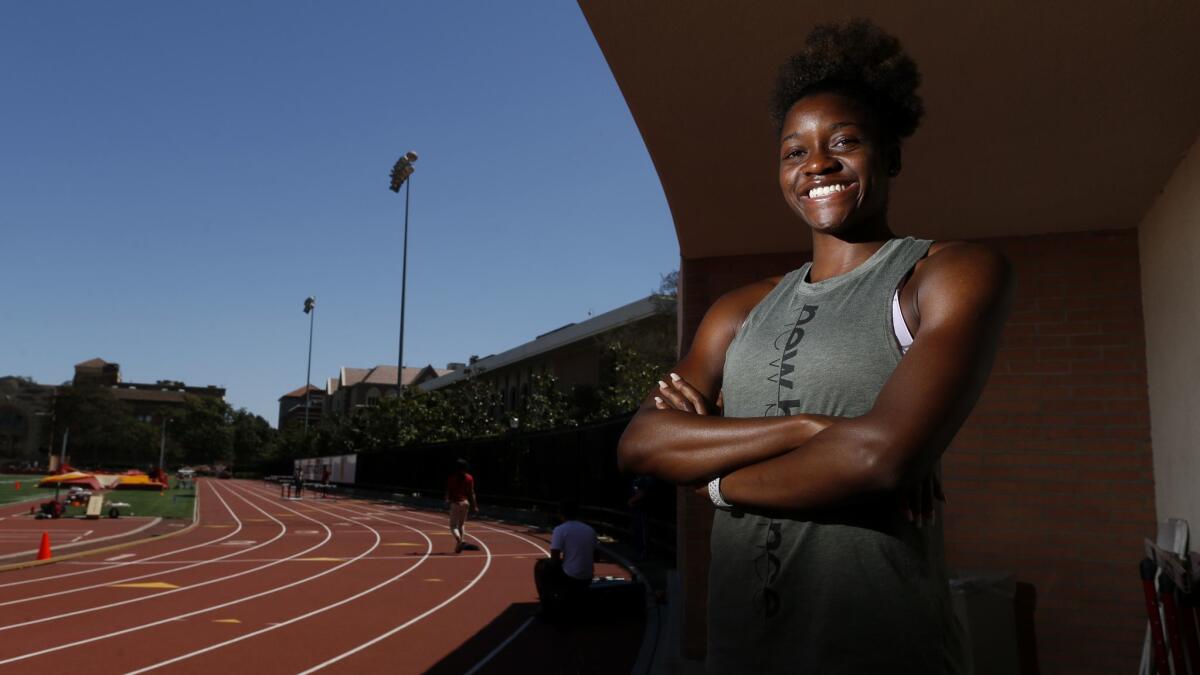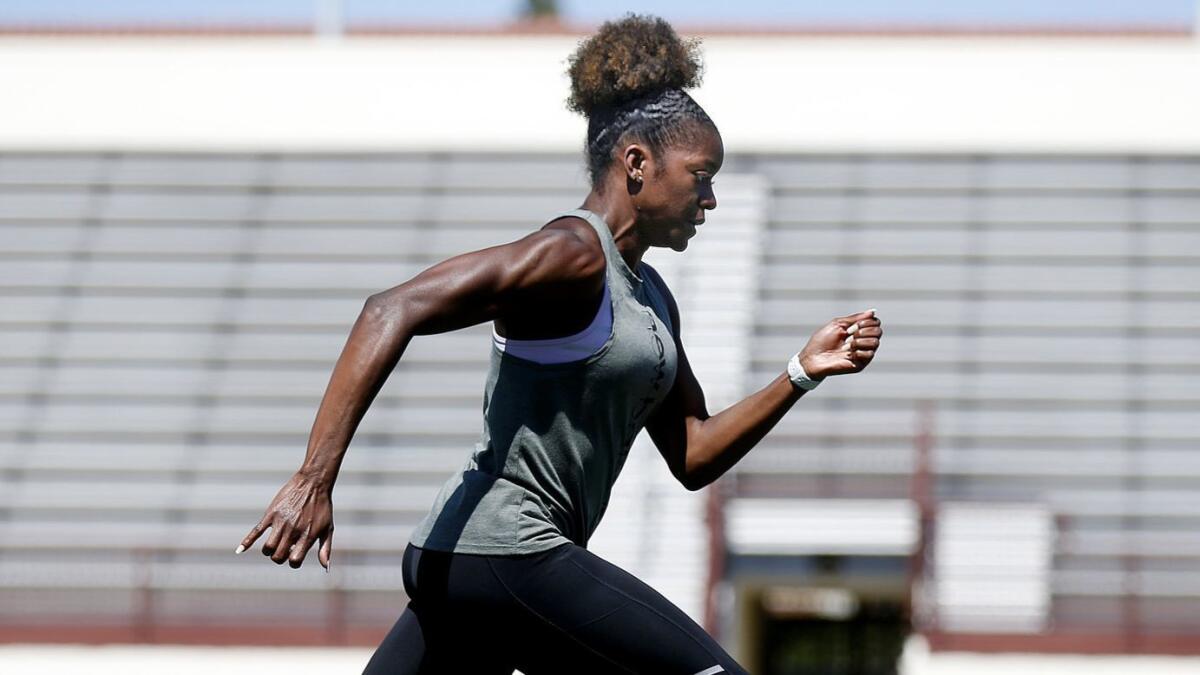Kendall Ellis, Jaide Stepter hope Mt. SAC Relays lead to run for big money

- Share via
Ten months ago, Kendall Ellis was a very big deal.
As a senior on the USC track team, she went viral on social media with a near-miraculous anchor leg in the 1,600-meter relay at the NCAA championships, charging from 20 meters back to win at the line and give the Trojans women a national title.
But when Ellis settles into the blocks for the 400 meters at the Mt. SAC Relays on Saturday, it will be a case of ‘What have you done for me lately?’
“I have to prove myself,” she said. “Every time I step onto the track, it’s time to make a statement.”
That’s because the 23-year-old from Florida has left the relative security of college sports for the cutthroat world of professional track and field.
Now she has to run fast, every time out, to get invited to more lucrative meets this summer. She has to travel the world in search of prize money. And she has to show results to pay for rent and food and training.
If Ellis needs a reminder of what’s at stake, she can talk to another former Trojan competing Saturday. Jaide Stepter is entering her third season as a pro and still feels the pressure, even though she is ranked sixth in the world in the 400.
“I did anticipate it would be a challenge,” Stepter said of turning pro, “but I was not really prepared. It has been so much harder than I expected.”
The Mt. SAC Relays aren’t among the glitziest meets in the sport — no prize money is involved — but the event has a tradition of attracting top high school, college and elite talent in the early season.
The list of past winners includes Olympic stars such as Carl Lewis, Ato Boldon, Al Oerter on the men’s side and Merlene Ottey, Evelyn Ashford and Jackie Joyner-Kersee for the women.
This year, the meet at El Camino College will feature Brianna Rollins-McNeal, the reigning Olympic champion in the 100-meter hurdles, highly ranked long jumper Lorraine Ugen and Michael Norman, the world indoor record holder at 400 meters.
It also marks the beginning of a crucial stretch, with the world championships only a few months away and the Tokyo Olympics following in the summer of 2020.
Sieg Lindstrom, managing editor of Track & Field News, said that if a successful pro career requires being good at the right time, “now is one of those times.”
Not only are the sport’s best preparing to compete for spots on national teams, they’re also fighting for endorsement money that ramps up at this point in the Olympic cycle.
Mt. SAC results could help determine who receives invitations for the start of the Diamond League, a fourth-month pro circuit with most of its stops in Europe. “That’s where the real money is,” Ellis said.
Though track superstars get appearance fees and guaranteed lanes at every meet, others such as Ellis and Stepter must continually prove themselves.
“You’ve got to perform at a high level all the time,” said USC coach Caryl Smith Gilbert, who still works with Ellis. “The race you’re in this week will determine if you get to race next week.”
As for money, Ellis gave herself some cushion by signing an endorsement deal with New Balance. The fame from that relay victory helped; so did the fact that her resume includes a sub-50 second time, an important benchmark in the 400.

“I’m in good financial position,” she said. “It’s enough to keep me going through this season.”
The future is not quite as certain for Stepter.
An All-American at USC, the 24-year-old has edged into the top 10 internationally but has yet to sign with a sponsor. She stays afloat through a combination of prize money, freelance assignments as a graphic designer and television jobs in commercials that need athletes.
“Sometimes I have speaking lines but for the most part it’s action,” she said.
Athletes can also get help from their national federation and the U.S. Olympic Committee, but paying for rent and food remains a worry for many.
“Everyone hits tough times,” Smith Gilbert said. “At this level, it shows how much you really love the sport.”
Last week, when Stepter got an invitation to the 2019 Grenada Invitational, which offers prize money, she hopped on a plane for the Caribbean and finished second in the 400.
Such travel must be weighed against the disruption in training, a common risk-reward scenario for American athletes who have few U.S. meets to choose from.
Sign up for our daily sports newsletter »
“The longer you’re gone, that’s more time away from your coach and training and a regular regimen and the food you’re used to eating,” Stepter said. “You definitely want to make the trip worthwhile.”
The U.S. season has only a few domestic meets with prize money, including the Prefontaine Classic in Eugene, Ore. — the lone Diamond League stop on American soil — in June. First comes Mt. SAC, where the schedule includes a full-range of elite events, including relays.
Norman and Rai Benjamin will lead a strong men’s 1,600-meter team. On the women’s side, Rollins-McNeal will join up with another Olympic gold medalist in Dalilah Muhammad.
After racing in their individual events, Ellis and Stepter will be teammates on a 1,600-meter relay squad.
It’s all about putting up times that will get them invited to more-lucrative races over the next few months.
In the life of a pro track athlete, patience can be key, Stepter said. As a newcomer to this level, nearly a year after her big splash in college, Ellis suspects that won’t always be easy.
“I think I have a tendency to put pressure on myself,” she said. “Nothing’s guaranteed.”
Follow @LAtimesWharton on Twitter
More to Read
Go beyond the scoreboard
Get the latest on L.A.'s teams in the daily Sports Report newsletter.
You may occasionally receive promotional content from the Los Angeles Times.











